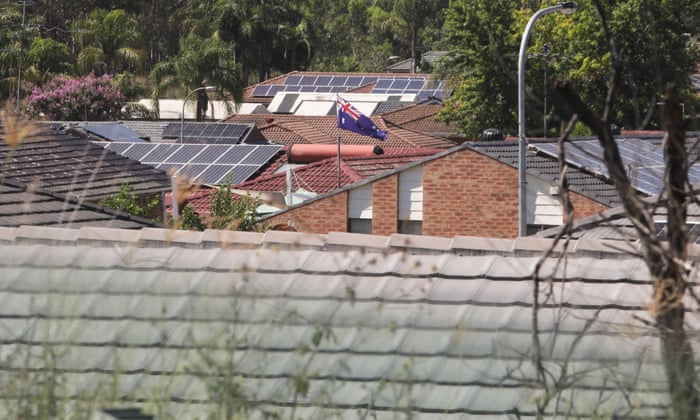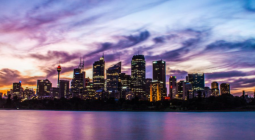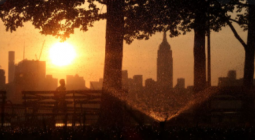How are our cities going to look in a rapidly heating world? It won’t be long before 50C will be normal

Hot weather bakes in disadvantage. Regenerating natural and living ecosystems will help us all
Acentury ago the British critic and crime writer GK Chesterton declared that crime fiction is the poetry of the city. Chesterton’s point was that the city is more attuned to the poetry of contemporary life than the country, but his observation also hit upon something no less important, which is that the structures that shape social and economic life are visible in their concentrated forms in the urban environment.
This is especially true when it comes to the impacts of global heating. As our cities get hotter the inequities embedded in them are intensifying rapidly. A 45C day in Sydney’s inner city isn’t fun, but residents of the affluent suburbs close to the centre tend to live in well-appointed, air-conditioned houses and apartments, as well as enjoying easy access to beaches, parks, pools and libraries where they can find refuge from the heat.
But a 45C day in the inner city is likely to be a 47C or a 48C day in the outer west, and lower levels of socioeconomic advantage mean these even more extreme temperatures are often being endured in lower-quality houses, with less effective ventilation and insulation. Greater dependence upon rental accommodation and social housing also means less control over the amenities available: air-conditioning is often only provided if a landlord agrees to install it. And even where air-conditioning is available, the expense of running it is prohibitive for many people.
Nor do residents in outer suburbs enjoy the same access to community facilities as their well-heeled neighbours to the east; in their absence they are often thrown back on other, less welcoming options when they need to shelter from the heat.
In a study conducted by Resilient Sydney and the Sydney Environment Institute in the aftermath of Sydney’s 2016-17 heatwaves, members of focus groups described taking advantage of the free air-conditioning in shopping centres and Returned Services League clubs. But many also acknowledged the limitations of this strategy: licensed clubs are not safe spaces for those with alcohol or gambling problems, while others spoke of the stress of the crowds and of managing children in shopping centres over extended periods.
Respondents in the same study also emphasised the problems of transport in the heat. Without cars people are forced to rely on public transport, but trains have a habit of failing during extreme weather, causing delays that make it difficult to get to work or to meet other commitments. And even when they are running, buses and trains are not always air-conditioned: one respondent spoke of having to catch a brutally hot bus with a one-year-old baby.

Even walking becomes a challenge: one woman said “taking three children out in the hot sun” for school pickup was “just absolutely excruciating”, only to concede, “There’s no other way, you have to do it.”
Others talked about the effect of power failures, of days in apartments that felt like ovens, or of managing children with health problems and behavioural issues in conditions of extreme discomfort, of the psychological distress and social isolation of being trapped at home and unable to get outside.
These examples paint a vivid portrait of the ways in which a changing climate is intersecting with other forms of disadvantage in Australian cities, multiplying the stresses upon the already disadvantaged and sharpening pre-existing vulnerabilities. And this process is accelerating. In January last year the mercury reached 48.9C in Penrith, but it’s reasonable to assume that by the end of this decade (and quite possibly before) we will be experiencing temperatures in excess of 50C in some parts of Sydney, as well as similar temperatures in other capital cities.
Nor are these problems going away. Despite the impacts of Covid-19, Australian cities are going to get bigger and more crowded in coming decades. Meanwhile, the need to reduce greenhouse emissions is going to force us to make difficult decisions about their layout and organisation, increasing density in many areas and building transport corridors to move people about more efficiently.
But this is also good news. Because it means we have an opportunity to reshape our cities and make them work better for all of us. And one of the most important ways we do this is by regenerating natural systems and incorporating living ecosystems into the urban environment.
There are lots of good reasons for embracing the use of living systems in our cities. Trees and other green infrastructure such as plant walls are not only one of the most efficient mechanisms for managing heat in urban areas, reducing temperatures by up to eight degrees, they also decrease energy use by cooling buildings, improve air quality and absorb carbon dioxide. Similarly, restoring natural vegetation improves the health of rivers and wetlands. And attempts to regenerate the vast system of oyster reefs that once surrounded much of the continent are not only having startling effects on biodiversity and water quality, but helping regenerate seagrass beds, which in turn protect fragile coastlines from storm damage by absorbing wave energy.
Incorporating living ecosystems into our cities is also good for us in more direct ways. Proximity to water and trees has repeatedly been shown to reduce stress levels, increase our sense of connection and improve our state of mind. This is particularly important for children: one UK study showed disadvantaged children who attended “forest school” – basically half a day a week in the outdoors – showed significant improvements in school attendance, academic attainment, stress levels and emotional wellbeing.
The continuing presence of natural systems in our lives is also vital in another, less obvious way. Contact with trees and water and animals encourages us to think of ourselves as part of the natural world, not as something separate from it. And that’s desperately important because the brutal fact is that the only way any of us will survive the next century is by rethinking these relationships.

This is particularly true here in Australia, where our urban environments are landscapes of erasure that obscure not just the deep histories of the Indigenous peoples who once cared for them but the violence of their dispossession. In these spaces the plants and animals that once inhabited them are made fugitive, extirpated in favour of the radically simplified ecosystems of suburban houses, gardens, parks and nature strips. This violence is even encoded in the topography: the wide streets of the Adelaide beachside suburb of Glenelg where I grew up were once a system of lagoons and wetlands teeming with fish and birdlife, while in the 1940s the mouth of the Cooks River that flows near my home in Sydney was moved a kilometre and a half to accommodate construction at Sydney airport.
Neither the ecological nor the cultural loss caused by this destruction can ever be fully undone. But what survives is often startling in its richness and diversity. Along the Hawkesbury River on Sydney’s fringes a remarkable project is speaking Darug history back into life, allowing pre-invasion landscapes and Indigenous cultural knowledge to emerge from the settled landscape like a palimpsest. And on a far smaller scale, a project in which 350 sq m of what was once bare grass in a park in Sydney’s inner west was left untended, has seen an astonishing 21 species of native ground cover burst forth from the previously degraded soil, germinating from seeds that have lain dormant for a century or more. As these regenerated systems develop they grow more complex and diverse, sequestering carbon dioxide in the soil, developing intricate networks of fungus and other organisms, and attracting native bees and birds.
None of these solutions are without their complexities or contradictions. The success of green infrastructure such as trees depends upon councils and other bodies planting species that are appropriate not just to our current climate but to the hotter and more extreme climates of coming decades. Similarly, some tree species can create new problems, as some residents in Sydney have discovered when planting programs focused on particular species led to flooding when the trees dropped their leaves and blocked drains.
Perhaps even more importantly, the adoption of these nature-based solutions needs to be handled in a way that does not further entrench disadvantage: while initiatives like the City of Sydney’s Greening Sydney 2030 (and especially its emphasis upon equitable access to shade) are vital, it is important to recognise that councils in less-advantaged areas often lack the resources to carry out large-scale planting programs.
As recent summers clearly demonstrate, the climate crisis is already reshaping our world. That process will only grow more extreme and more convulsive in years to come. Meeting these challenges requires far more than tree planting and ecosystem regeneration. But the successes of nature-based solutions are an eloquent reminder that a survivable future is also, of necessity, a fairer, more just and healthier future.
-
James Bradley is an Australian novelist and critic
-
This is an edited version of a talk given for the Green Living Centre for World Environment Day
14 June 2021
The Guardian




